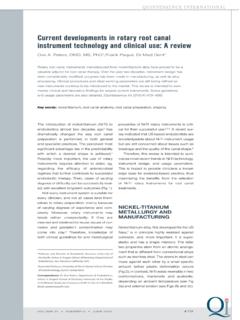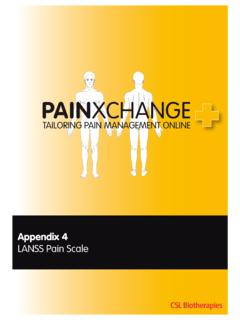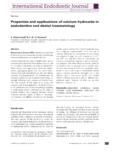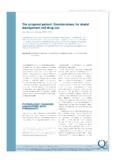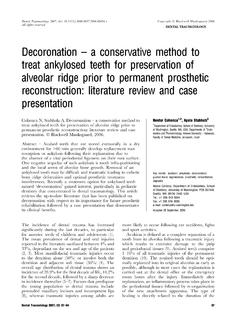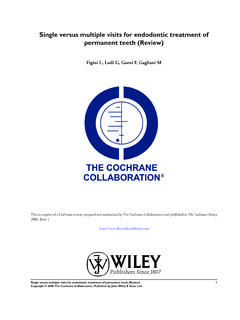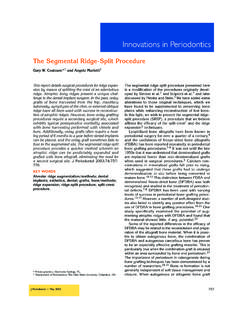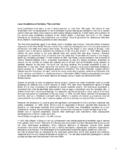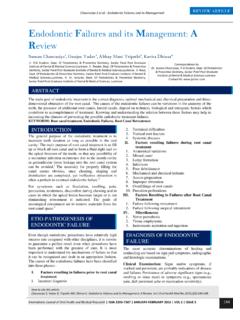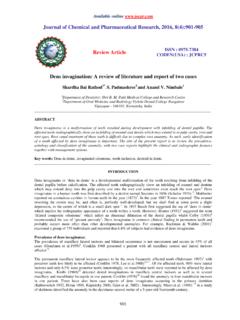Transcription of Irrigation in Endodontics - EndoExperience
1 Irrigation inEndodonticsMarkus Haapasalo,DDS, PhDa,*, Ya Shen,DDS, PhDa,Wei Qian,DDS, PhDb, Yuan Gao,DDS, PhDcThe success of endodontic treatment depends on the eradication of microbes(if present) from the root - canal system and prevention of reinfection. The root canalis shaped with hand and rotary instruments under constant Irrigation to remove theinflamed and necrotic tissue, microbes/biofilms, and other debris from the root -canalspace. The main goal of instrumentation is to facilitate effective Irrigation , disinfection,and filling. Several studies using advanced techniques such as microcomputedtomography (CT) scanning have demonstrated that proportionally large areas of themain root - canal wall remain untouched by the instruments,1emphasizing the impor-tance of chemical means of cleaning and disinfecting all areas of the root canal (Figs.)
2 1and2). There is no single irrigating solution that alone sufficiently covers allof the functions required from an irrigant. Optimal Irrigation is based on the combineduse of 2 or several irrigating solutions, in a specific sequence, to predictably obtain thegoals of safe and effective Irrigation . Irrigants have traditionally been delivered into theroot- canal space using syringes and metal needles of different size and tip experience and research have shown, however, that this classic approachtypically results in ineffective Irrigation , particularly in peripheral areas such as anasto-moses between canals, fins, and the most apical part of the main root canal . There-fore, many of the compounds used for Irrigation have been chemically modified andseveral mechanical devices have been developed to improve the penetration andeffectiveness of Irrigation .
3 This article summarizes the chemistry, biology, and proce-dures for safe and efficient Irrigation and provides cutting-edge information on themost recent of Endodontics , Department of Oral Biological & Medical Sciences, UBC Faculty ofDentistry, The University of British Columbia, 2199 Wesbrook Mall, Vancouver, BC, CanadaV6T 1Z3bGraduate Endodontics Program, Faculty of Dentistry, The University of British Columbia, 2199 Wesbrook Mall, Vancouver, BC, Canada V6T 1Z3cState Key Laboratory of Oral Diseases, West China College & Hospital of Stomatology, SichuanUniversity, Chengdu, China* Corresponding Endodontics Irrigation root canal IrrigantDent Clin N Am 54 (2010) 291 312 $ see front matter 2010 Elsevier Inc.
4 All rights OF IRRIGATIONI rrigation has a central role in endodontic treatment. During and after instrumentation,the irrigants facilitate removal of microorganisms, tissue remnants, and dentin chipsfrom the root canal through a flushing mechanism (Box 1). Irrigants can also helpprevent packing of the hard and soft tissue in the apical root canal and extrusion of in-fectedmaterial into theperiapicalarea. Someirrigatingsolutions dissolveeitherorganicor inorganic tissue in the root canal . In addition, several irrigating solutions have antimi-crobial activity and actively kill bacteria and yeasts when introduced in direct contactwith the microorganisms. However, several irrigating solutions also have cytotoxicpotential, and they may cause severe pain if they gain access into the optimal irrigant should have all or most of the positive characteristics listedinBox 1, but none of the negative or harmful properties.
5 None of the available irrigatingsolutions can be regarded as optimal. Using a combination of products in the correctirrigation sequence contributes to a successful treatment SOLUTIONSS odium HypochloriteSodium hypochlorite (NaOCl) is the most popular irrigating solution. NaOCl ionizes inwater into Na1and the hypochlorite ion, OCl , establishing an equilibrium withFig. scanning electron microscopy image of dentin surface covered by predentin andother organic debris in an uninstrumented canal of uninstrumented root - canal et al292hypochlorous acid (HOCl). At acidic and neutral pH, chlorine exists predominantlyas HOCl, whereas at high pH of 9 and above, OCl is responsible for the antibacterial activity; the OCl ion is less effectivethan the undissolved HOCl.
6 Hypochloric acid disrupts several vital functions of themicrobial cell, resulting in cell ,5 NaOCl is commonly used in concentrations between and 6%. It is a potentantimicrobial agent, killing most bacteria instantly on direct contact. It also effectivelydissolves pulpal remnants and collagen, the main organic components of is the only root - canal irrigant of those in general use that dissolvesnecrotic and vital organic tissue. It is difficult to imagine successful Irrigation of theroot canal without hypochlorite. Although hypochlorite alone does not remove thesmear layer, it affects the organic part of the smear layer, making its complete removalpossible by subsequent Irrigation with EDTA or citric acid (CA).
7 It is used as an unbuf-fered solution at pH 11 in the various concentrations mentioned earlier, or bufferedwith bicarbonate buffer (pH ), usually as a (Dakin solution) or 1% , buffering does not seem to have any major effect on the properties ofNaOCl, contrary to earlier is considerable variation in the literature regarding the antibacterial effect ofNaOCl. In some articles hypochlorite is reported to kill the target microorganisms inseconds, even at low concentrations, although other reports have published consid-erably longer times for the killing of the same 10 Such differences are a resultof confounding factors in some of the studies. The presence of organic matter duringthe killing experiments has a great effect on the antibacterial activity of and colleagues11showed that the presence of dentin caused markeddelays in the killing ofEnterococcus faecalisby 1% NaOCl.
8 Many of the earlier studieswere performed in the presence of an unknown amount of organic matter (eg, nutrientbroth) or without controlling the pH of the culture, both of which affect the result. Whenthe confounding factors are eliminated, it has been shown that NaOCl kills the targetmicroorganisms rapidly even at low concentrations of less than ,12 However, invivo the presence of organic matter (inflammatory exudate, tissue remnants, microbialbiomass) consumes NaOCl and weakens its effect. Therefore, continuous irrigationand time are important factors for the effectiveness of m and Sundqvist13,14studied the Irrigation of root canals that were necroticand contained a mixture of anaerobic bacteria. These investigators showed that usingBox 1 Desired functions of irrigating solutions Washing action (helps remove debris) Reduce instrument friction during preparation (lubricant) Facilitate dentin removal (lubricant) Dissolve inorganic tissue (dentin) Penetrate to canal periphery Dissolve organic matter (dentin collagen, pulp tissue, biofilm) Kill bacteria and yeasts (also in biofilm)
9 Do not irritate or damage vital periapical tissue, no caustic or cytotoxic effects Do not weaken tooth structureIrrigation in or 5% NaOCl, with or without EDTA for Irrigation , resulted in considerable reduc-tion of bacterial counts in the canal when compared with Irrigation with , it was difficult to render the canals completely free from bacteria, even afterrepeated sessions. Siqueira and colleagues15reported similar results using rootcanals infected withE faecalis. Both studies failed to show a significant difference inthe antibacterial efficacy between the low and high concentrations of NaOCl. Contraryto these results, Clegg and colleagues,16in an ex vivo biofilm study, demonstrateda strong difference in the effectiveness against biofilm bacteria by 6% and 3% NaOCl,the higher concentration being more weaknesses of NaOCl include the unpleasant taste, toxicity, and its inability toremove the smear layer (Fig.)
10 3) by itself, as it dissolves only organic limited antimicrobial effectiveness of NaOCl in vivo is also disappointing. Thepoorer in vivo performance compared with in vitro is probably caused by problemsin penetration to the most peripheral parts of the root - canal system such as fins,anastomoses, apical canal , lateral canals, and dentin canals. Also, the presence ofinactivating substances such as exudate from the periapical area, pulp tissue, dentincollagen, and microbial biomass counteract the effectiveness of , ithas been shown by in vitro studies that long-term exposure of dentin to a high concen-tration sodium hypochlorite can have a detrimental effect on dentin elasticity andflexural ,19 Although there are no clinical data on this phenomenon, it raisesthe question of whether hypochlorite in some situations may increase the risk ofvertical root summary, sodium hypochlorite is the most important irrigating solution and theonly one capable of dissolving organic tissue, including biofilm and the organic partof the smear layer.
